Impact of Fertilizer on Crop Yield and C:N:P Stoichiometry in Arid and Semi-Arid Soil
Abstract
1. Introduction
2. Materials and Methods
2.1. Study Area
2.2. Field Experiment and Design
2.3. Soil Sampling and Analysis
2.4. Statistical Analysis
3. Results
3.1. Crop Yield
3.2. Soil Nutrients
3.3. Soil C:N:P Stoichiometry
3.4. The Relationship among Various Parameters
4. Discussion
4.1. Long-Term Fertilization Altered Crop Yield
4.2. Long-Term Fertilization Altered Soil Nutrients
4.3. Long-Term Fertilization Altered C:N:P Stoichiometry in Soil
5. Conclusions
Supplementary Materials
Author Contributions
Funding
Institutional Review Board Statement
Informed Consent Statement
Data Availability Statement
Acknowledgments
Conflicts of Interest
References
- Zeng, Q.; Li, X.; Dong, Y.; An, S.; Darboux, F. Soil and plant components ecological stoichiometry in four steppe communities in the Loess Plateau of China. Catena 2016, 147, 481–488. [Google Scholar] [CrossRef]
- Tian, D.; Reich, P.B.; Chen, H.Y.H.; Xiang, Y.; Luo, Y.; Shen, Y.; Meng, C.; Han, W.; Niu, S.M. Global changes alter plant multi-element stoichiometric coupling. New Phytol. 2019, 221, 807–817. [Google Scholar] [CrossRef] [PubMed]
- Elser, J.J.; Sterner, R.W.; Gorokhova, E.; Fagan, W.F.; Markow, T.A.; Cotner, J.B.; Harrison, J.F.; Hobbie, S.E.; Odell, G.M.; Weider, L.J. Biological stoichiometry from genes to ecosystems. Ecol. Lett. 2000, 3, 540–550. [Google Scholar] [CrossRef]
- Ma, Y.; Li, J.; Li, X.; Tang, X.; Liang, Y.; Huang, S.; Wang, B.; Liu, H.; Yang, X. Phosphorus accumulation and depletion in soils in wheat-maize cropping systems: Modeling and validation. Field Crop. Res. 2009, 110, 207–212. [Google Scholar] [CrossRef]
- Carter, C.A.; Zhong, F.; Zhu, J. Advances in Chinese Agriculture and its Global Implications. Appl. Econ. Perspect. Policy 2012, 34, 1–36. [Google Scholar]
- Choudhary, M.; Meena, V.S.; Panday, S.C.; Mondal, T.; Yadav, R.P.; Mishra, P.K.; Bisht, J.K.; Pattanayak, A. Long-term effects of organic manure and inorganic fertilization on biological soil quality indicators of soybean-wheat rotation in the Indian mid-Himalaya. Appl. Soil Ecol. 2021, 157, 103754. [Google Scholar] [CrossRef]
- Wang, Y.; Bauke, S.L.; von Sperber, C.; Tamburini, F.; Guigue, J.; Winkler, P.; Kaiser, K.; Honermeier, B.; Amelung, W. Soil phosphorus cycling is modified by carbon and nitrogen fertilization in a long-term field experiment. J. Plant Nutr. Soil Sci. 2021. [Google Scholar] [CrossRef]
- MacDonald, G.K.; Bennett, E.M.; Potter, P.A.; Ramankutty, N. Agronomic phosphorus imbalances across the world’s croplands. Proc. Natl. Acad. Sci. USA 2011, 108, 3086–3091. [Google Scholar] [CrossRef]
- Chen, D.; Yuan, L.; Liu, Y.; Ji, J.; Hou, H. Long-term application of manures plus chemical fertilizers sustained high rice yield and improved soil chemical and bacterial properties. Eur. J. Agron. 2017, 90, 34–42. [Google Scholar] [CrossRef]
- Gosal, S.K.; Gill, G.K.; Sharma, S.; Walia, S.S. Soil nutrient status and yield of rice as affected by long-term integrated use of organic and inorganic fertilizers. J. Plant Nutr. 2018, 41, 539–544. [Google Scholar] [CrossRef]
- Cai, A.; Xu, H.; Duan, Y.; Zhang, X.; Ashraf, M.N.; Zhang, W.; Xu, M. Changes in mineral-associated carbon and nitrogen by long-term fertilization and sequestration potential with various cropping across China dry croplands. Soil Tillage Res. 2021, 205, 104725. [Google Scholar] [CrossRef]
- Yang, D.; Song, L.; Jin, G. The soil C:N:P stoichiometry is more sensitive than the leaf C:N:P stoichiometry to nitrogen addition: A four-year nitrogen addition experiment in a Pinus koraiensis plantation. Plant Soil 2019, 442, 183–198. [Google Scholar] [CrossRef]
- Luo, S.; Gao, Q.; Wang, S.; Tian, L.; Zhou, Q.; Li, X.; Tian, C. Long-term fertilization and residue return affect soil stoichiometry characteristics and labile soil organic matter fractions. Pedosphere 2020, 30, 703–713. [Google Scholar] [CrossRef]
- Zhou, Y.; Boutton, T.W.; Wu, X.B. Soil C:N:P stoichiometry responds to vegetation change from grassland to woodland. Biogeochemistry 2018, 140, 341–357. [Google Scholar] [CrossRef]
- Yu, Z.; Wang, M.; Huang, Z.; Lin, T.C.; Vadeboncoeur, M.A.; Searle, E.B.; Chen, H.Y.H. Temporal changes in soil C-N-P stoichiometry over the past 60 years across subtropical China. Glob. Chang. Biol. 2018, 24, 1308–1320. [Google Scholar] [CrossRef]
- Zechmeister-Boltenstern, S.; Keiblinger, K.M.; Mooshammer, M.; Penuelas, J.; Richter, A.; Sardans, J.; Wanek, W. The application of ecological stoichiometry to plant-microbial-soil organic matter transformations. Ecol. Monogr. 2015, 85, 133–155. [Google Scholar] [CrossRef]
- Zhai, J.Y.; Song, Y.H.; Entemake, W.; Xu, H.W.; Wu, Y.; Qu, Q.; Xue, S. Change in Soil Particle Size Distribution and Erodibility with Latitude and Vegetation Restoration Chronosequence on the Loess Plateau, China. Int. J. Environ. Res. Public Health 2020, 17, 822. [Google Scholar] [CrossRef]
- Liu, Q.; Mu, X.M.; Zhao, G.J.; Gao, P.; Sun, W.Y. Effects of Fertilization on Soil Water Use Efficiency and Crop Yield on the Loess Plateau, China. Appl. Ecol. Environ. Res. 2020, 18, 6555–6568. [Google Scholar] [CrossRef]
- Bao, S.D. Soil Agrochemical Analysis; China Agriculture Press: Beijing, China, 2020. [Google Scholar]
- Ameen, A.; Liu, J.; Han, L.; Xie, G.H. Effects of nitrogen rate and harvest time on biomass yield and nutrient cycling of switchgrass and soil nitrogen balance in a semiarid sandy wasteland. Ind. Crop. Prod. 2019, 136, 1–10. [Google Scholar] [CrossRef]
- Liu, Q.; Xu, H.; Mu, X.; Zhao, G.; Gao, P.; Sun, W. Effects of Different Fertilization Regimes on Crop Yield and Soil Water Use Efficiency of Millet and Soybean. Sustainability 2020, 12, 4125. [Google Scholar] [CrossRef]
- Lu, J.; Yang, M.; Liu, M.; Lu, Y.; Yang, H. Nitrogen and phosphorus fertilizations alter nitrogen, phosphorus and potassium resorption of alfalfa in the Loess Plateau of China. J. Plant Nutr. 2019, 42, 2234–2246. [Google Scholar] [CrossRef]
- Cui, X.; Zhang, Y.; Gao, J.; Peng, F.; Gao, P. Long-term combined application of manure and chemical fertilizer sustained higher nutrient status and rhizospheric bacterial diversity in reddish paddy soil of Central South China. Sci. Rep. 2018, 8, 16554. [Google Scholar] [CrossRef] [PubMed]
- Wei, Z.; Yang, T.; Friman, V.P.; Xu, Y.; Shen, Q.; Jousset, A. Trophic network architecture of root-associated bacterial communities determines pathogen invasion and plant health. Nat. Commun. 2015, 6, 8413. [Google Scholar] [CrossRef]
- Xu, H.; Qu, Q.; Li, P.; Guo, Z.; Wulan, E.; Xue, S. Stocks and Stoichiometry of Soil Organic Carbon, Total Nitrogen, and Total Phosphorus after Vegetation Restoration in the Loess Hilly Region, China. Forests 2019, 10, 27. [Google Scholar] [CrossRef]
- Allison, S.D.; Czimczik, C.I.; Treseder, K.K. Microbial activity and soil respiration under nitrogen addition in Alaskan boreal forest. Glob. Chang. Biol. 2008, 14, 1156–1168. [Google Scholar] [CrossRef]
- Compton, J.E.; Watrud, L.S.; Arlene Porteous, L.; DeGrood, S. Response of soil microbial biomass and community composition to chronic nitrogen additions at Harvard forest. For. Ecol. Manag. 2004, 196, 143–158. [Google Scholar] [CrossRef]
- Shen, C.; Xiong, J.; Zhang, H.; Feng, Y.; Lin, X.; Li, X.; Liang, W.; Chu, H. Soil pH drives the spatial distribution of bacterial communities along elevation on Changbai Mountain. Soil Biol. Biochem. 2013, 57, 204–211. [Google Scholar] [CrossRef]
- Schade, J.D.; Kyle, M.; Hobbie, S.E.; Fagan, W.F.; Elser, J.J. Stoichiometric tracking of soil nutrients by a desert insect herbivore. Ecol. Lett. 2003, 6, 96–101. [Google Scholar] [CrossRef]
- Sollins, P.; Homann, P.; Caldwell, B.A. Stabilization and destabilization of soil organic matter: Mechanisms and controls. Geoderma 1996, 74, 65–105. [Google Scholar] [CrossRef]
- Reich, P.B.; Oleksyn, J. Global patterns of plant leaf N and P in relation to temperature and latitude. Proc. Natl. Acad. Sci. USA 2004, 101, 11001–11006. [Google Scholar] [CrossRef]
- An, H.; Li, G. Effects of grazing on carbon and nitrogen in plants and soils in a semiarid desert grassland, China. J. Arid Land 2015, 7, 341–349. [Google Scholar] [CrossRef]
- Cleveland, C.C.; Liptzin, D. C:N:P stoichiometry in soil: Is there a “Redfield ratio” for the microbial biomass? Biogeochemistry 2007, 85, 235–252. [Google Scholar] [CrossRef]
- Tian, H.; Chen, G.; Zhang, C.; Melillo, J.M.; Hall, C.A.S. Pattern and variation of C:N:P ratios in China’s soils: A synthesis of observational data. Biogeochemistry 2010, 98, 139–151. [Google Scholar] [CrossRef]
- Tischer, A.; Potthast, K.; Hamer, U. Land-use and soil depth affect resource and microbial stoichiometry in a tropical mountain rainforest region of southern Ecuador. Oecologia 2014, 175, 375–393. [Google Scholar] [CrossRef] [PubMed]

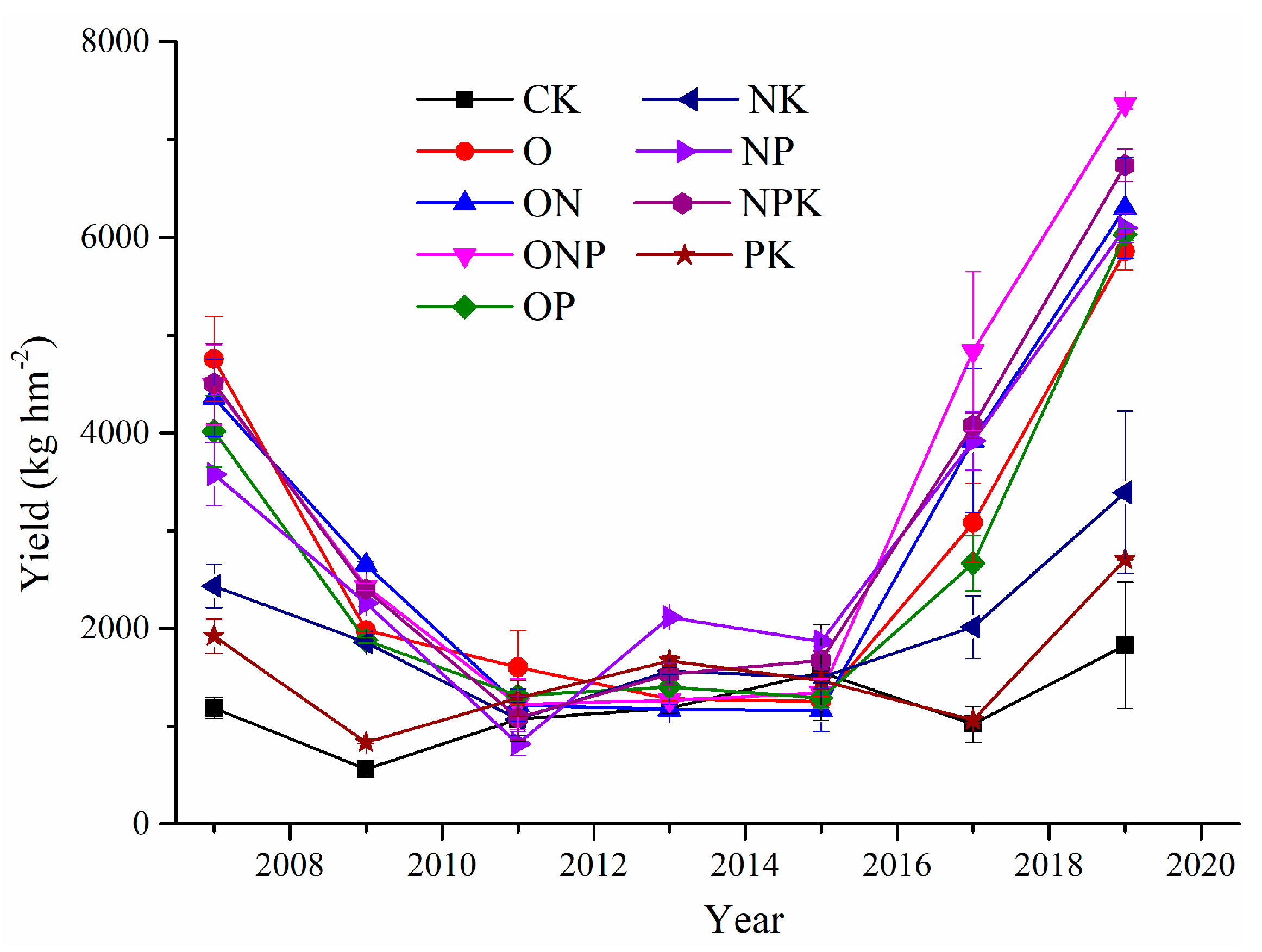
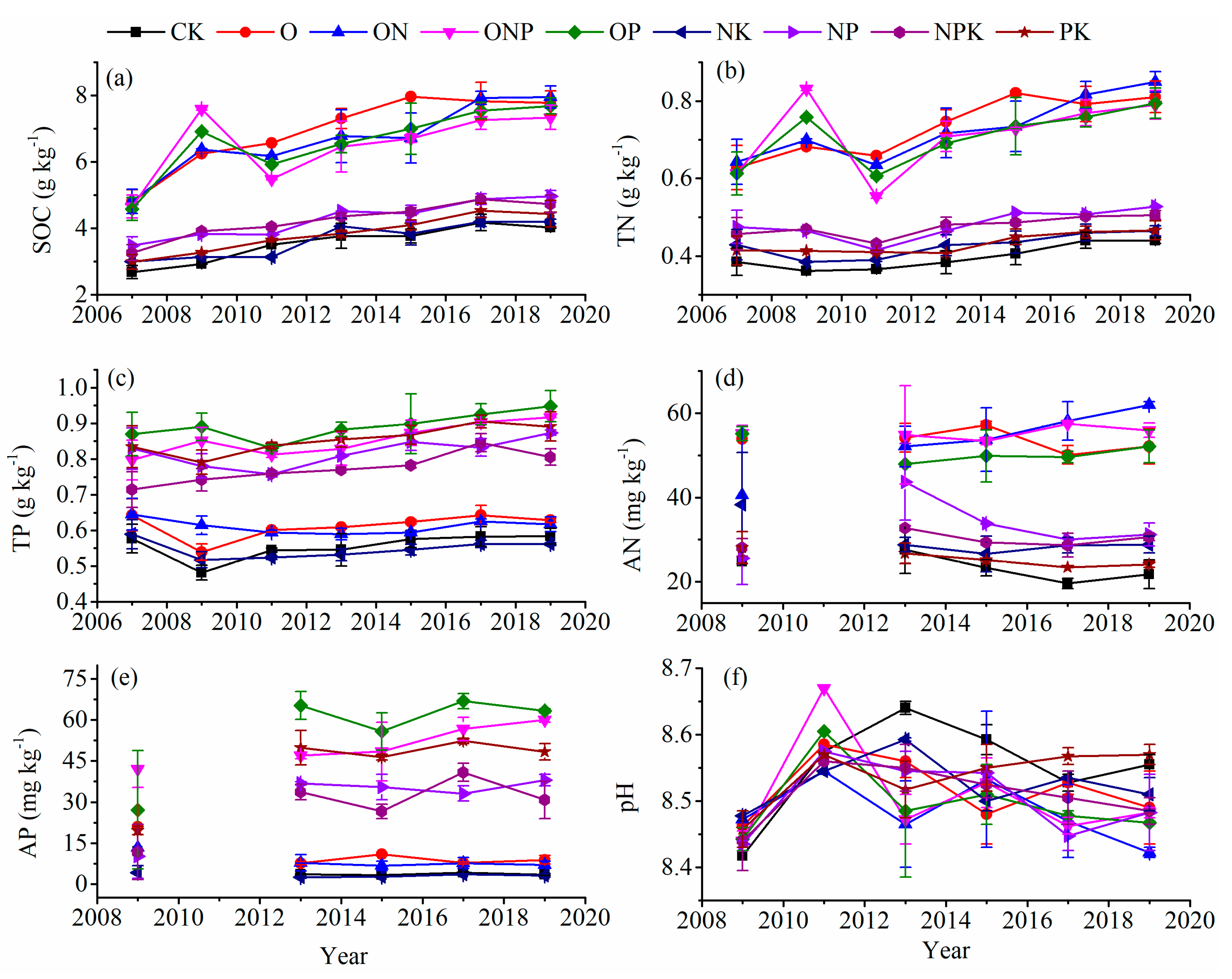
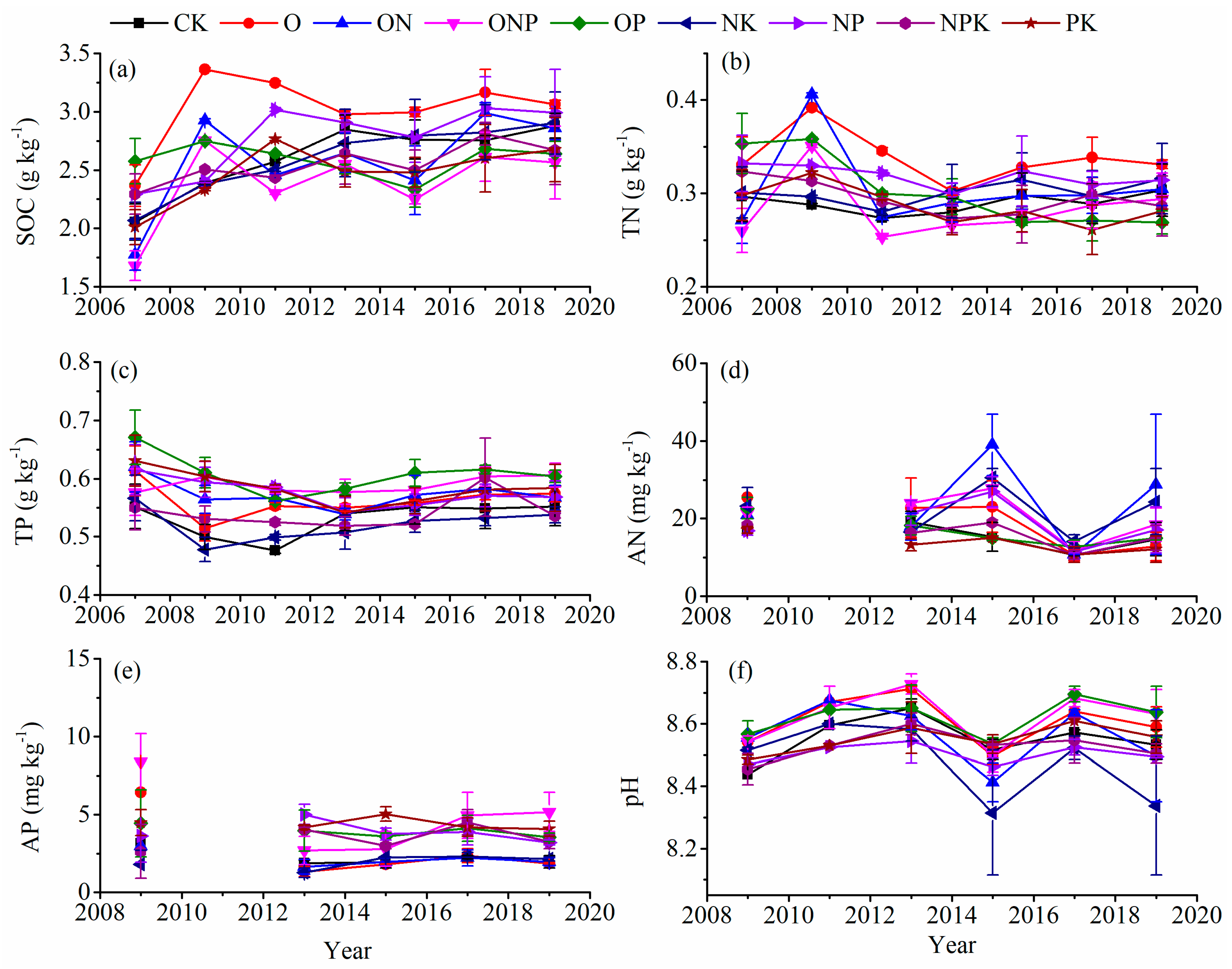
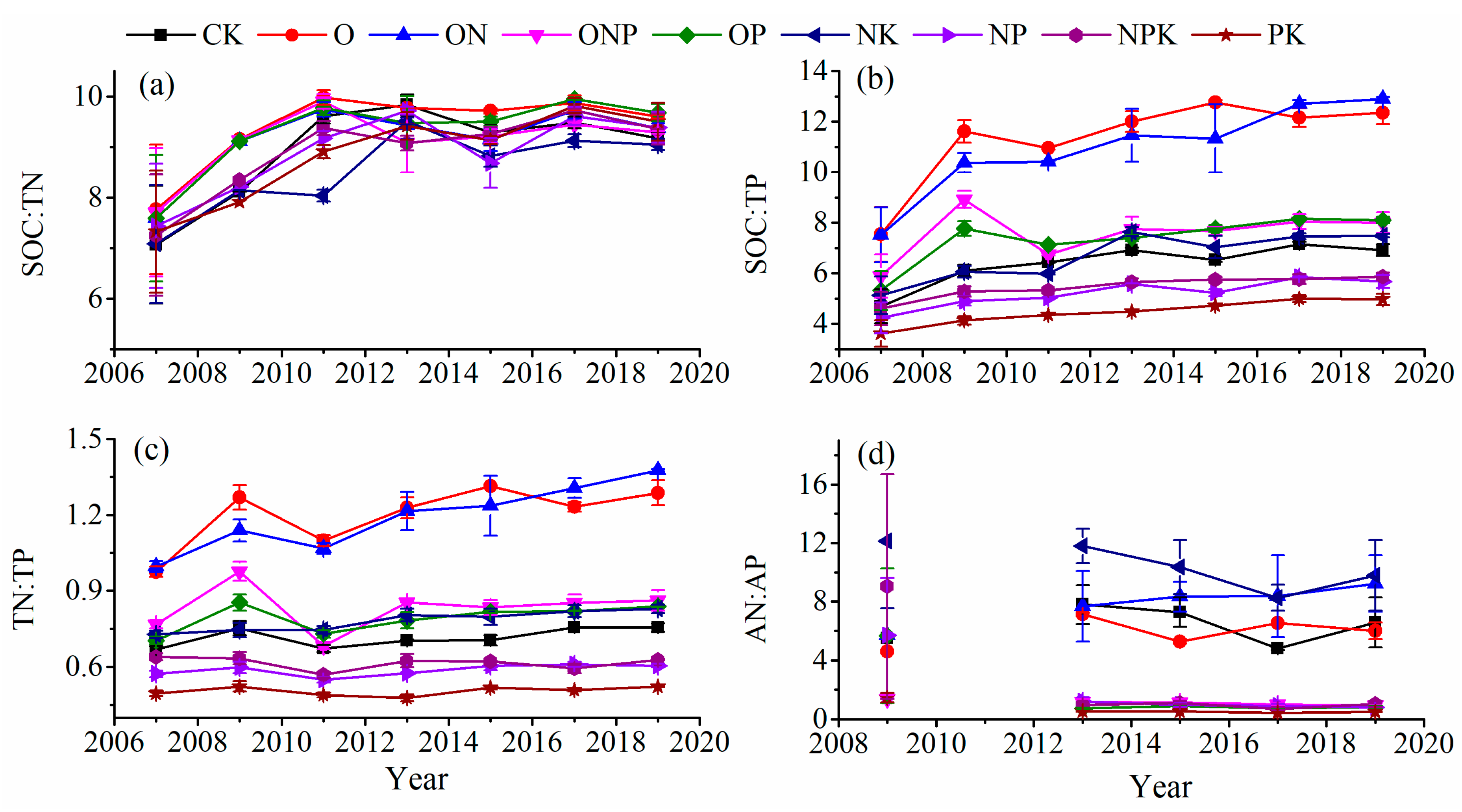
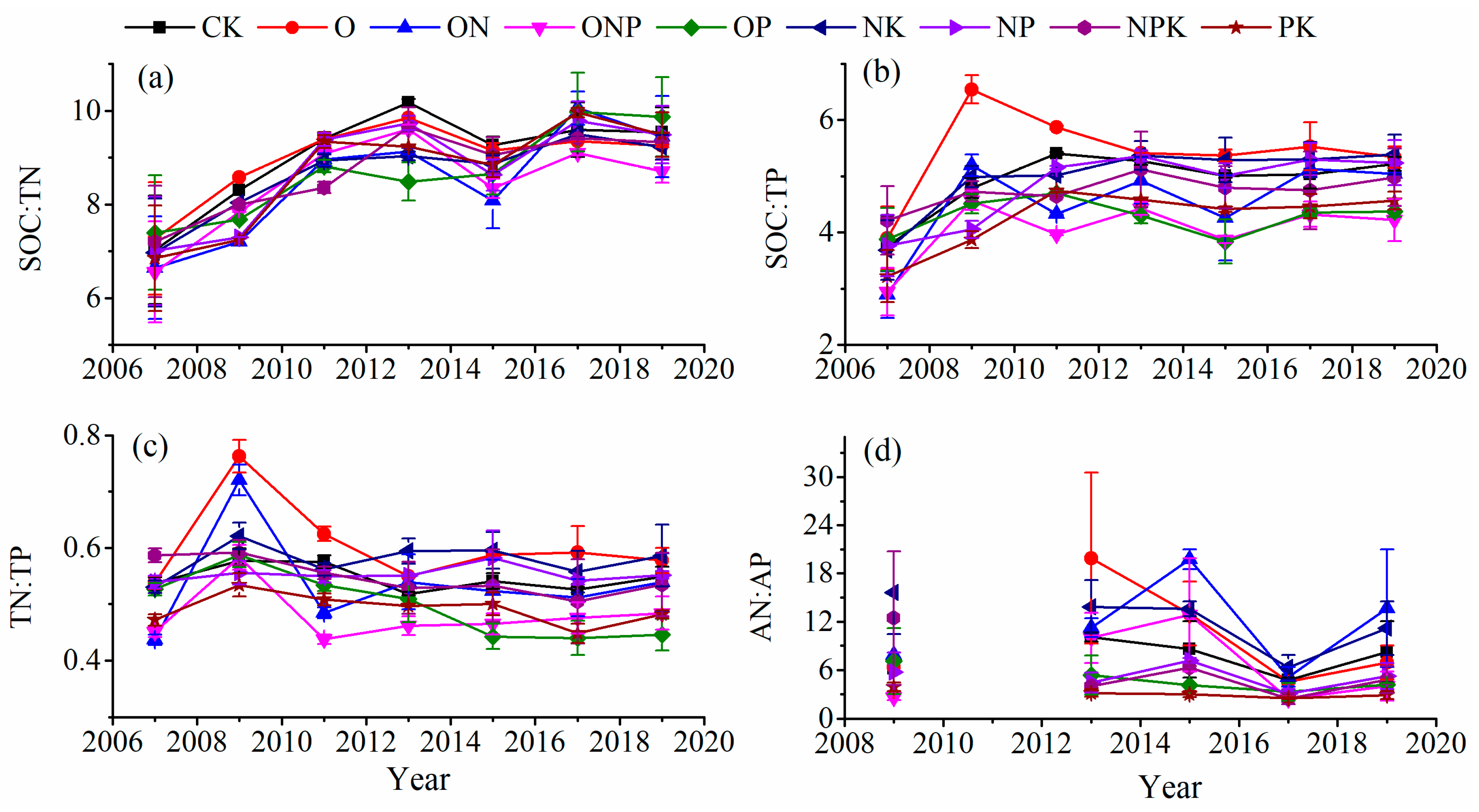
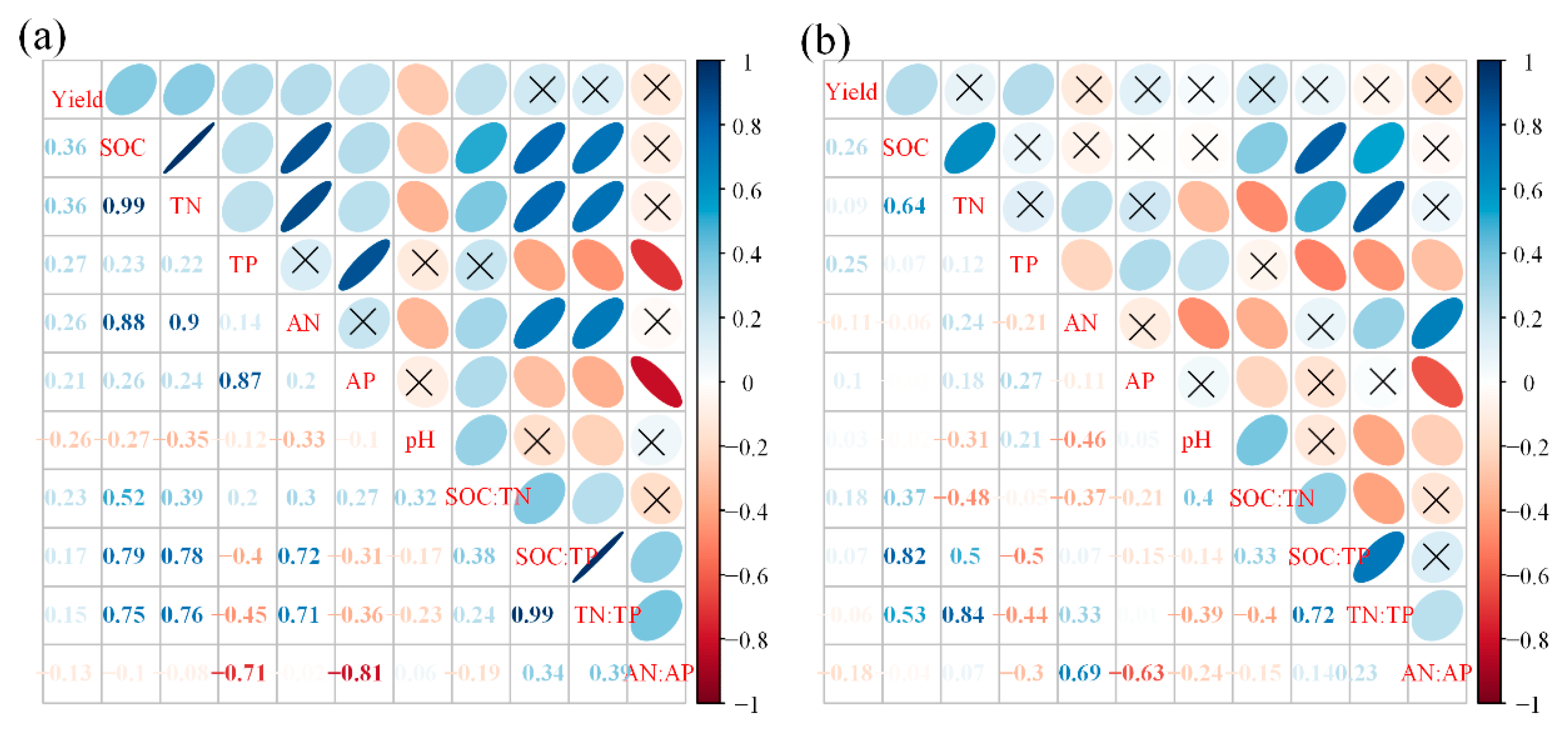
| Experimental Plots | ||||||||
|---|---|---|---|---|---|---|---|---|
| 1 ON | 2 O | 3 NPK | 4 PK | 5 NK | 6 NP | 7 CK | 8 PNK | 9 PP |
| 10 OP | 11 ON | 12 PK | 13 NK | 14 CK | 15 NPK | 16 NK | 17 O | 18 ONP |
| 19 ONP | 20 OP | 21 CK | 22 NK | 23 NP | 24 PK | 25 NPK | 26 ON | 27 O |
| 28 O | 29 ONP | 30 NP | 31 CK | 32 NPK | 33 NK | 34 PK | 35 OP | 36 ON |
| Treatment | Illustration |
|---|---|
| CK | No fertilizer |
| O | 0.75 kg/m2 organic fertilizer |
| ON | 0.75 kg/m2 organic fertilizer and 0.021 kg/m2 nitrogen |
| ONP | 0.75 kg/m2 organic fertilizer, 0.021 kg/m2 nitrogen and 0.017 kg/m2 phosphorus |
| OP | 0.75 kg/m2 organic fertilizer and 0.017 kg/m2 phosphorus |
| NP | 0.017 kg/m2 phosphorus and 0.021 kg/m2 nitrogen |
| NK | 0.012 kg/m2 potash and 0.021 kg/m2 nitrogen |
| NPK | 0.012 kg/m2 potash, 0.021 kg/m2 nitrogen and 0.017 kg/m2 phosphorus |
| PK | 0.012 kg/m2 potash and 0.017 kg/m2 phosphorus |
| Indexes | Year | FT | Year × FT | ||||
|---|---|---|---|---|---|---|---|
| F | P | F | P | F | P | ||
| Yield | 279.13 | 0.00 | 40.49 | 0.00 | 10.29 | 0.00 | |
| 0–20 cm | SOC | 16.73 | 0.00 | 137.24 | 0.00 | 1.14 | 0.34 |
| TN | 11.07 | 0.00 | 185.63 | 0.00 | 1.24 | 0.25 | |
| TP | 10.53 | 0.00 | 149.99 | 0.00 | 0.51 | 0.98 | |
| AN | 0.39 | 0.81 | 39.33 | 0.00 | 0.85 | 0.68 | |
| AP | 6.93 | 0.00 | 64.29 | 0.00 | 2.30 | 0.00 | |
| pH | 8.41 | 0.00 | 2.80 | 0.01 | 0.96 | 0.54 | |
| SOC:TN | 37.90 | 0.00 | 5.97 | 0.00 | 2.04 | 0.01 | |
| SOC:TP | 8.22 | 0.00 | 296.55 | 0.00 | 1.63 | 0.07 | |
| TN:TP | 2.69 | 0.04 | 361.38 | 0.00 | 1.67 | 0.06 | |
| AN:AP | 1.38 | 0.26 | 13.55 | 0.00 | 0.66 | 0.89 | |
| 20–40 cm | SOC | 3.13 | 0.02 | 5.47 | 0.00 | 0.92 | 0.60 |
| TN | 10.84 | 0.00 | 4.41 | 0.00 | 1.14 | 0.34 | |
| TP | 2.74 | 0.04 | 6.64 | 0.00 | 0.61 | 0.93 | |
| AN | 9.31 | 0.00 | 2.77 | 0.01 | 0.94 | 0.57 | |
| AP | 2.87 | 0.03 | 5.61 | 0.00 | 1.15 | 0.33 | |
| pH | 8.99 | 0.00 | 3.51 | 0.00 | 0.55 | 0.96 | |
| SOC:TN | 43.09 | 0.00 | 1.83 | 0.10 | 1.36 | 0.17 | |
| SOC:TP | 1.72 | 0.16 | 12.41 | 0.00 | 1.23 | 0.26 | |
| TN:TP | 14.57 | 0.00 | 9.69 | 0.00 | 1.10 | 0.38 | |
| AN:AP | 4.69 | 0.00 | 4.74 | 0.00 | 0.98 | 0.52 | |
Publisher’s Note: MDPI stays neutral with regard to jurisdictional claims in published maps and institutional affiliations. |
© 2021 by the authors. Licensee MDPI, Basel, Switzerland. This article is an open access article distributed under the terms and conditions of the Creative Commons Attribution (CC BY) license (https://creativecommons.org/licenses/by/4.0/).
Share and Cite
Liu, Q.; Xu, H.; Yi, H. Impact of Fertilizer on Crop Yield and C:N:P Stoichiometry in Arid and Semi-Arid Soil. Int. J. Environ. Res. Public Health 2021, 18, 4341. https://doi.org/10.3390/ijerph18084341
Liu Q, Xu H, Yi H. Impact of Fertilizer on Crop Yield and C:N:P Stoichiometry in Arid and Semi-Arid Soil. International Journal of Environmental Research and Public Health. 2021; 18(8):4341. https://doi.org/10.3390/ijerph18084341
Chicago/Turabian StyleLiu, Qiang, Hongwei Xu, and Haijie Yi. 2021. "Impact of Fertilizer on Crop Yield and C:N:P Stoichiometry in Arid and Semi-Arid Soil" International Journal of Environmental Research and Public Health 18, no. 8: 4341. https://doi.org/10.3390/ijerph18084341
APA StyleLiu, Q., Xu, H., & Yi, H. (2021). Impact of Fertilizer on Crop Yield and C:N:P Stoichiometry in Arid and Semi-Arid Soil. International Journal of Environmental Research and Public Health, 18(8), 4341. https://doi.org/10.3390/ijerph18084341







